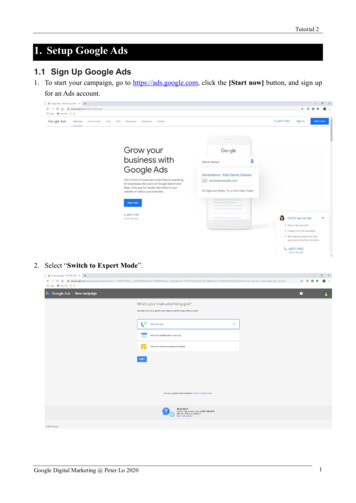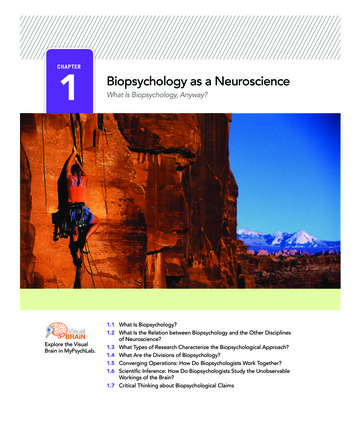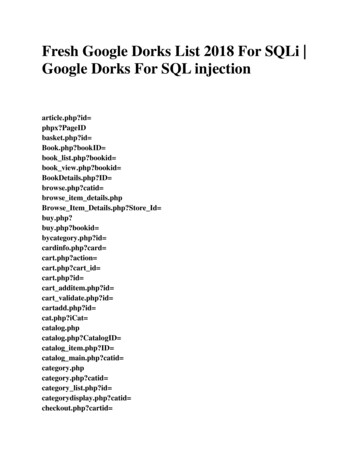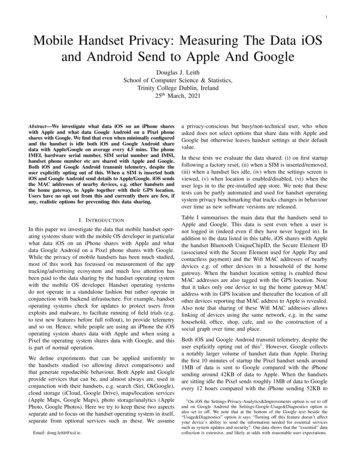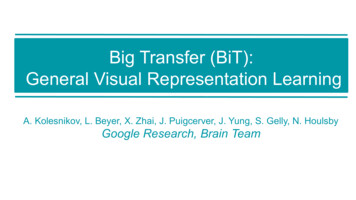
Transcription
Big Transfer (BiT):General Visual Representation LearningA. Kolesnikov, L. Beyer, X. Zhai, J. Puigcerver, J. Yung, S. Gelly, N. HoulsbyGoogle Research, Brain Team
Outline Paper SummaryTransfer LearningBig Transfer UpStream TrainingDownstream TrainingExperiments and ResultsDiscussionQuiz questions
Paper SummaryTrain on GenericLarge SupervisedDatasetFine Tune onTarget Task Scale Up Pre-Training Train ResNet152x4 on JFT 300M dataset. Shows how to train models at such scale. Fine Tune this model to different tasks (20) Cheap fine-tuning Only few hyper-params need to be tuned. Fine Tuned models perform very well.
Transfer LearningTask 1Task 2Task 1Task 2Dataset 1Dataset 2Dataset 1Dataset 2Classical LearningTransfer Learning
Why Transfer Learning? Scarcity of Labelled Data Train Just one model. Training Models for everytask is expensive and timeconsuming Fine tuning it to other taskstake less data and lesscompute. There is redundant workin training Promotes Reuse.
Big Transfer (BiT)M1D1Generic ModelTrainingD2LargeGenericDatasetDNUpStream TrainingDownStream TrainingM2M3
BiT Components (Ingredients)UpStream ComponentsDownStream Components Large Scale Dataset and Model Task Specific Dataset Group Normalization Fine-Tuning Protocol Weight Standardization Bit-HyperRule
Upstream Training
Data for Upstream TrainingModelData SetRemarksBiT-SILSVRC-2012 variant ofImageNet1.28M images, 1000classes, 1 label/imageBiT-MImageNet-21k14.2M images, 21k classesJFT-300M300M images, 1.26labels/image, 18291classes,20% noisy labels due toautomatic annotationsBiT-L
Normalization Normalize activations along subset of (N,C,H,W) dimensions.Faster and stable training of NNsMakes Loss function smooth and hence optimization is easier.https://arxiv.org/pdf/1803.08494.pdf
Group Normalization Normalize over groups ofchannels. Not all channels areequally important. Layer Normalization andInstance Normalization arespecial cases of GN. More effective then BN whenbatch size is very small. ButBN is better with bigger batchsizeshttps://arxiv.org/pdf/1803.08494.pdf
Weight Standardization Normalizes weights insteadof activations. Helps in smoothing theloss landscape. Works well in conjunctionwith GN in low batch sizeregime.https://arxiv.org/pdf/1903.10520.pdf
Summary of Upstream TrainingModelData Parallel TrainingOptimization ResNet 152 x4 Global BS 4096 SGD with Momentum(0.9), weight Decay(1e-4) Each hidden layerwidened by x4 Train on TPUv3-512 LR 0.03 and reduce byfactor of 10 after 10,23,30, 37 epochs. (BiT-L) Train for 40 epochs Linear LR warmup for first5K opt. Steps 8 img/chip Use GN WS928 Million paramsSame model for alldatasets
DownStream Training
DownStream ComponentsGoal : Cheap fine-tuningBiT-HyperRuleData ProcessingOptimization SGD with Momentum(0.9), weight Decay(1e-4) LR 0.003 and reduce byfactor of 10 in laterepochs Epochs: Small: 500 Medium: 10K Large: 20K Most Hyper-Params need not bechanged. Depending on dataset size andimage resolution set the following, Training Schedule Length Image Resolution MixUp Regularization Small ( 20K), Medium ( 500K),Large( 500K) Random Crops andHorizontal Flips (alltasks)Smaller than 96x96 160x160 random crop128x128Larger, 448x448 random crop384x384
MixUp Regularization2Introduce new samples which areconvex combination of existing samples.11.2. Improves Generalization Reduces memorization of corrupt labels. Increases Robustness to adversarialexamples. Used mixup with alpha 0.1 for large andmedium 8728f15c559https://arxiv.org/pdf/1710.09412.pdf
Experiments
Downstream TasksBenchmarks ILSVRC-2012 CIFAR 10/100 Oxford-IIIT Pet Oxford Flowers-102Datasets differ in Total number of images Input resolution Nature of categories- ImageNet and CIFAR (general)- Pets and Flowers (fine-grained)Results reporting BiT fine-tuned on official training split Report results on official test split if availableelse use validation splitFurther assessment VTAB benchmark To assess generality of representationslearned by BiT 19 tasks, 1000 training samples each Three groups of tasks - natural, special,structured
Hyperparameter DetailsUpstream Pre-Training ResNetv2 architecture, each hiddenlayer widened by factor of 4(ResNet152x4)BN layers replaced by GN, WS in allconv layersSGD with momentum(0.9)Initial LR - 0.03 - decayed in all 3models by factor of 10 in later epochsBatch size - 4096, Linear learningrate warmup for 5000 steps, weightdecay of 0.0001Downstream Fine-Tuning BiT - HyperRuleResolution 96x96 160x160 - then random128x128 crop, Larger images resizeto 448x448 then 384x384 cropSchedule - Small - 20k ex, tune 500 steps,- Medium - 500k ex, tune 10k steps- Large - tune for 20k stepsMixUp - ɑ 0.1, for medium and largetasks
Results
Top-1 accuracy for BiT-LThe entries show median standard deviation across 3 fine-tuning runs.
Accuracy improvement with ImageNet-21kTop-1 accuracy is reported above. Both models are ResNet152x4
Few-Shot LearninglLSVRC-2012 - Top-1 accuracy of 72% with 5 samples/class, 84.1% with 100 samples/classCIFAR-100 - Top-1 accuracy of 82.6% with just 10 samples per class.
Results on VTABVTAB (19 tasks) with 1000 examples/task, and the current SOTA.
ObjectNet & Object Detection
Scaling Models and Datasets
Scaling Models and Datasets
Optimization for large datasets
Large Batches, Group Normalization, Weight Standardization
Criticism and Future work Upstream Training is expensive, requires lot of resources (GPU etc.)These models may be poisonous or may contain backdoors ?
Thank you!
Discussion
Quiz
Question 11. The authors find Batch Normalization to be detrimental for Big Transfer. Which other techniques aresuggested instead for upstream pre-training?a. Group Normalizationb. Weight Standardizationc. Dropoutd. MixUp regularizationAnswers :a. Group Normalizationb. Weight Standardization
Question 22. Which of the following statements are true?a. BiT uses extra unlabelled in-domain data.b. Lower weight decay results in a highly performant final model.c. BiT has 928 million parameters.d. Decaying learning rate too early leads to sub-optimal model.Answers :c. BiT has 928 million parameters.d. Decaying learning rate too early leads to sub-optimal model.
Question 33.Statement I : The authors perform random horizontal flipping or cropping of training images during finetuning, irrespective of the type of downstream task.Statement II : For fine-tuning BiT-L needs more samples per class.a. Statement I is false, Statement II is trueb. Statement I is true, Statement II is falsec. Both Statement I and II are trued. Both Statement I and II are falseAnswers :a. Both Statement I and II are false
Google Research, Brain Team Big Transfer (BiT): General Visual Representation Learning. Outline . Only few hyper-params need to be tuned. Fine Tuned models perform very well. Transfer Learn




